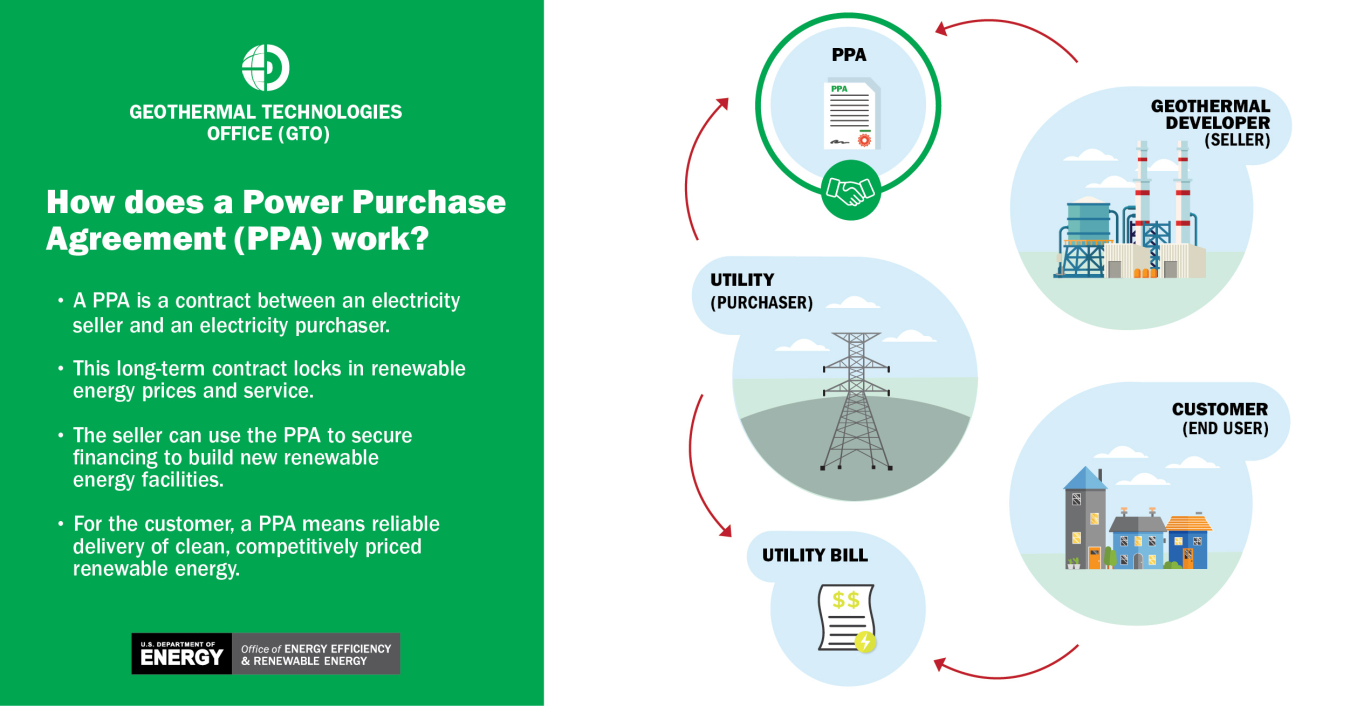Catch up by reading Chapter 1 and Chapter 2!
Among numerous highlights in the National Renewable Energy Laboratory’s recently published Geothermal Power Production and District Heating Market Report, one in particular stands out: Since 2019, 11 new geothermal power purchase agreements have been signed across four states. This is a big deal in renewable energy circles, but why should it matter to us, the energy consumers across the country?
Power purchase agreements are the contracts that allow utilities to procure electricity from power plants. These agreements help determine how much you ultimately pay for the electricity that charges your phone, fires up your television on game day, lights your home, and, in general, powers your life.
Cue lights, hit the mark….
Geothermal is Ready for Its Close Up
Building increased geothermal capacity to support the proliferation of power purchase agreements (PPAs) depends not only on repowering and expanding existing geothermal plants, but also successfully identifying new subsurface resources. Although the potential for geothermal energy is vast—more than 5,000 gigawatts of viable geothermal power resources exist across the United States[1]—locating new geothermal systems can be expensive, and the greatest risk is at the onset of an exploration program.
The Department of Energy’s Geothermal Technologies Office (GTO) takes a lead role in funding research and development that helps to reduce both cost and risk for geothermal developers and operators. GTO’s multi-year Play Fairway Analysis (PFA) initiative, launched in 2014, wrapped up last year with a retrospective analysis that demonstrated the successful use of PFA—a methodology used successfully in the oil and gas industry for decades—in accurately targeting economically viable geothermal resources in Nevada, Idaho, Washington, and Hawaii. This included newly discovered hidden systems in Gabbs Valley and Granite Springs, Nevada—both of which are in the proximity of existing geothermal power facilities.
The success of the PFA initiative led to last year’s launch of Geoscience Data Acquisition in Western Nevada (GeoDAWN), an interagency project led by GTO and the U.S. Geological Survey (USGS). Targeting the highly prospective Walker Lane region along the border between California and Nevada, GeoDAWN researchers are using lidar and airborne magnetic surveys to identify surface and near-surface characteristics favorable for both geothermal power and mineral recovery. Recovering various elements critical to high-tech manufacturing, such as lithium and manganese, creates a broader hybrid solution that appeals to geothermal operators.[2]
The initial success of GeoDAWN contributed to the recent launch of GeoFlight: Salton Trough. A joint effort between GTO and USGS, GeoFlight seeks to capture surface and near-surface geologic data in the Salton Sea region with the goal of identifying both new geothermal prospects and areas of highest potential for mineral recovery, namely lithium.
Another example of GTO research into geothermal areas in the western United States is the Innovative Geothermal Exploration through Novel Investigations of Undiscovered Systems (INGENIOUS) initiative. Launched in early 2021, INGENIOUS also draws momentum from the PFA initiative and seeks to accelerate discoveries of new, commercially viable, hidden systems across the broader Great Basin region. The goal is to create a comprehensive guide for geothermal operators and future research teams that includes predictive geothermal maps at both regional and prospect scale.[3]
GTO Director Dr. Susan Hamm notes that current research into geothermal systems in the western United States addresses not only near-term needs for the energy grid, but also helps drive the DOE’s longer-term goal of achieving net-zero carbon emissions by 2050.
“We have a green mission, an urgent mission driven by climate change, and geothermal is primed to play a key role,” Hamm said. “The proliferation of PPAs over the past couple of years is a great indicator of momentum that we think will increase significantly in the coming years. Our mission is to support that growth with R&D that helps operators find new resources and get them online as quickly and cost-effectively as possible.

[1] U.S. Department of Energy. 2019. GeoVision analysis. /eere/geothermal/geovision
[2] Hell’s Kitchen Geothermal Power and Lithium Extraction Facility is under development and will target lithium recovery; domestic U.S. resource potential exceeds 600,000 tons of lithium, the majority of which is found in the Salton Sea. U.S. Geological Survey. Lithium Data Sheet: Mineral Commodity Summaries 2020. https://pubs.usgs.gov/periodicals/mcs2020/mcs2020-lithium.pdf
[3] Great Basin Center for Geothermal Energy. 2021. INGENIOUS project overview. https://gbcge.org/current-projects/ingenious/
